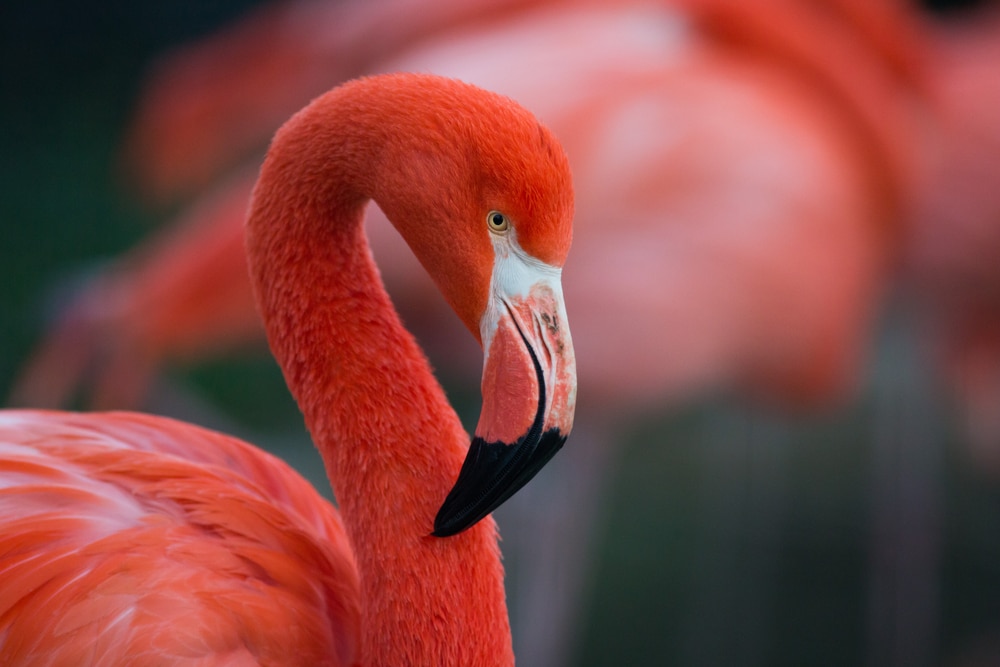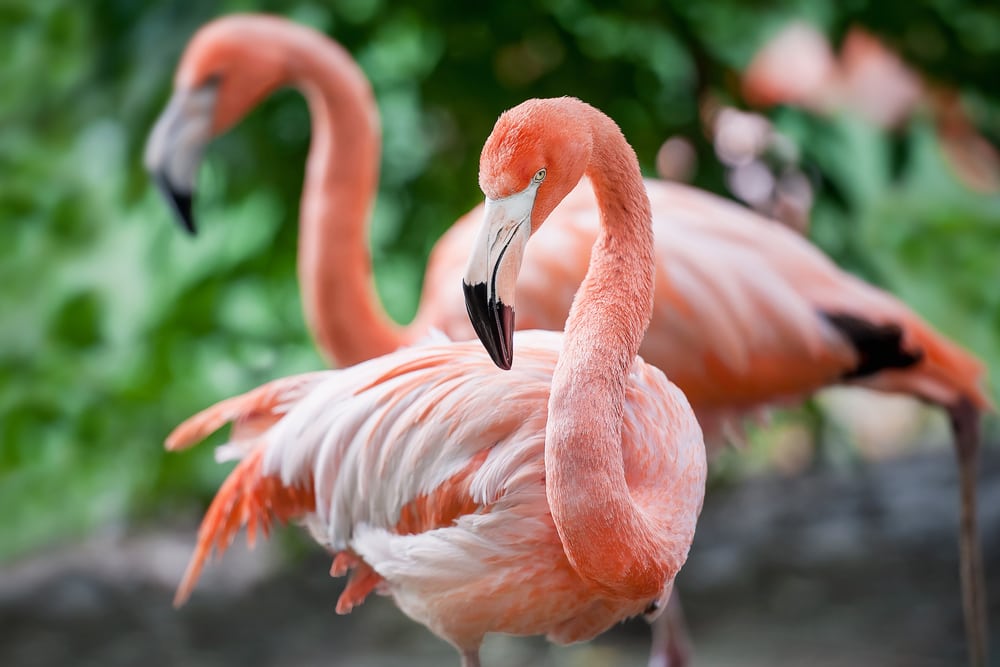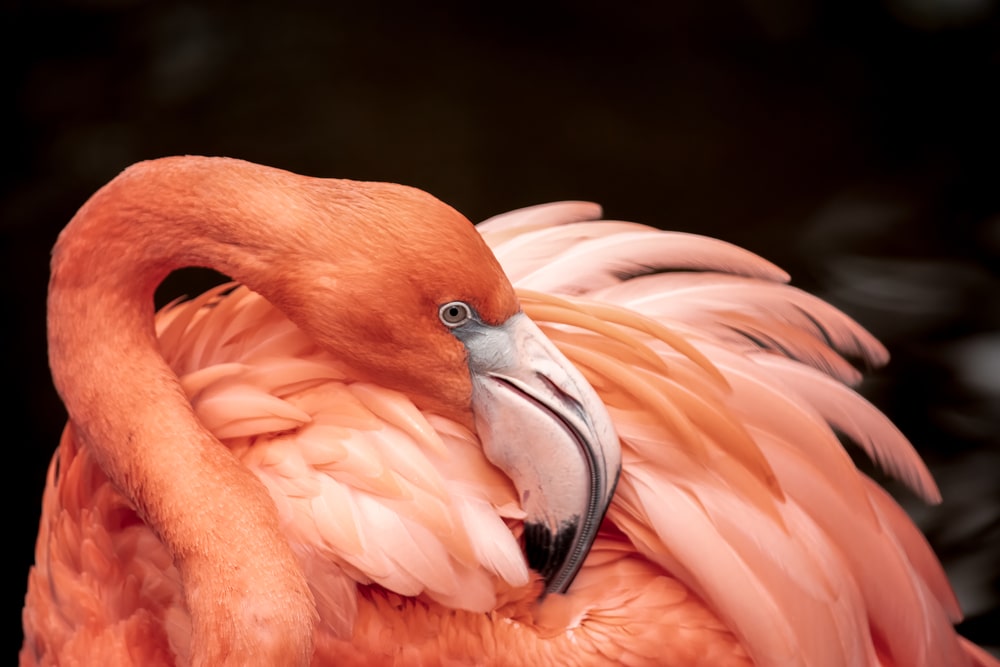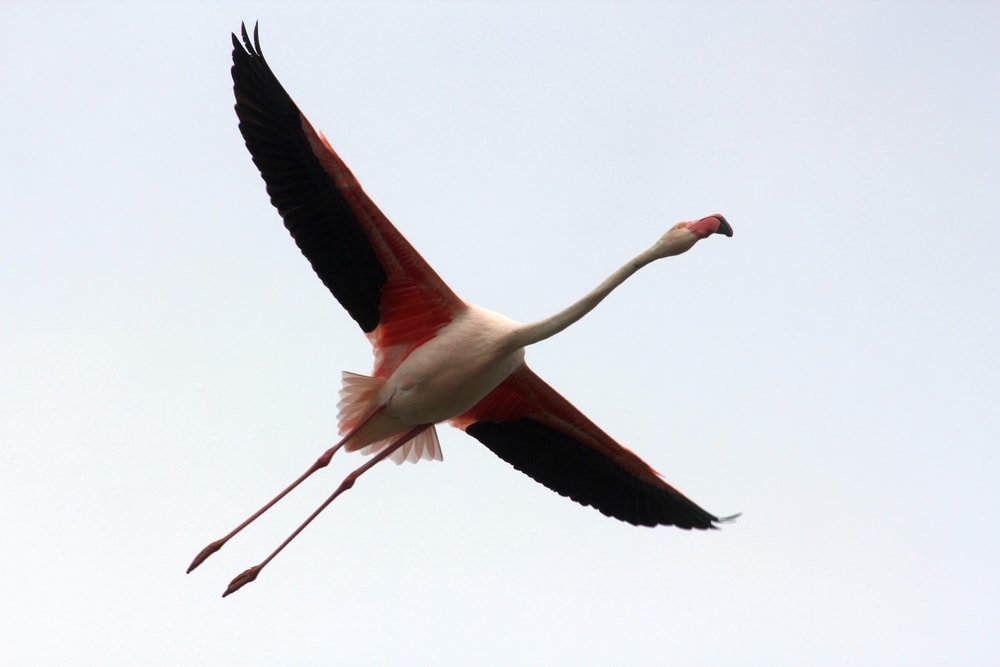Outforia Quicktake: Key Takeaways
- Flamingos can fly and are excellent fliers, traveling long distances at speeds of up to 31-37 mph.
- In the wild, they fly in groups called “flamboyance” and use a “V” formation to conserve energy.
- Flamingos in zoos have their wings clipped to prevent them from flying away.
- They are migratory birds, traveling 311-373 miles overnight to breed in temperate areas and find warmer climates.
- Flamingos are pink due to their diet of brine shrimp and algae, which determines the color of their feathers.
When people see flamingos in zoos, they often wonder why the animals don’t fly away. Their lack of flight in zoos makes people wonder if flamingos can even fly. Some people think they are flightless birds like penguins.
In reality, zoos clip their flamingos’ wings so they can’t fly away from the zoo. In the wild, flamingos are incredible fliers, traveling impressive distances at remarkable speeds.

SHARE THIS IMAGE ON YOUR SITE
<a href="https://outforia.com/can-flamingos-fly/"><img style="width:100%;" src="https://outforia.com/wp-content/uploads/2022/12/can-flamingos-fly-infographics-12012022.jpg"></a><br>Can Flamingos Fly <a href="https://outforia.com">Outforia</a>You May Also Like: 40 Different Types Of Birds Across The World: Photos + Facts
What Are Flamingos?

There are six species of flamingos, and they can all fly. The six species include:
- Caribbean Flamingo (Phoenicopterus ruber ruber)
- Greater Flamingo (Phoenicopterus ruber roseus)
- Chilean Flamingo (Phoenicopterus chilensis)
- Lesser Flamingo (Phoenicopterus minor)
- James’ Flamingo (Phoenicopterus jamesi)
- Andean Flamingo (Phoenicopterus andinus)
Coloration

The name “flamingo” comes from an old Portuguese word meaning “flame-colored.”
They get their bright pink or red color from the brine shrimp and algae that make up their diet. Flamingos may appear more white when kept in captivity. They do not always receive the proper diet and nutrition.
The six species of flamingos have slight color differences. The differences are due to subtle variations in their diet. Birds that eat more algae are darker in color than those that consume more brine shrimp.
Caribbean flamingos are typically the brightest-colored species. Their feathers are sometimes as dark as crimson. Chilean flamingos are the palest pink, their feathers almost white. Hatchlings are light gray or white. Juveniles are darker gray and may not become pink for up to two years.
Depending on the species, a flamingo’s legs and feet may range in color from yellow, orange, pink, or red.
Size

The total size depends on the species of flamingo. The largest is the greater flamingo which is 47-59 in (120-150 cm) tall and weighs up to 7.7 lbs (3.5 kg). Its wingspan reaches as much as 59 in (150 cm).
The lesser flamingo is the smallest species at 31.5 in (80 cm) tall and 5.5 lbs (2.5 kg). Its wingspan reaches 37-39 in (95-100 cm).
Legs

Flamingos are water birds with long legs perfect for wading in water. Their legs are far longer than most water birds, so they can wade deeper to hunt for fish. The legs are longer than their body, reaching up to 31.5-49 in (80-125 cm). Their ankle sits midway between their legs, and their knee sits close to their body.
While their legs are long and spindly, their feet are broad and webbed. They can walk across the muddy substrate because of their feet.
Once they reach deeper water, they swim to hunt for food. Their webbed feet help for easier and faster swimming. Unlike most water birds, flamingos probably don’t dive for food. Instead, they hold their breath while hunting.
Bill

Flamingos have long black, pink, or cream-colored bills that act as filters for feeding. There are ridges outside the bird’s bill that filter food from the water. The upper and lower part of the bill points downward past the nostril.
Flamingos have hair-like structures called lamellae. The lamellae is on their lower and upper bills to filter their food better. When they close their mouths, the lamellae on either bill come together to act as a filter. Their tongue is also covered in fleshy bristles to help with filtration.
Relatives

Flamingos are a type of bird in the order Ciconiiformes. They are relatives of storks, ibises, and herons. More recently, researchers have also given flamingos their own order, Phoenicopteriformes.
Flamingos are wading birds but are not related to other wading birds that look like them. They are more closely related to the grebe, a bird that looks very different from them.
Their bodies are unique and have stumped scientists for years. Their pelvis and ribs are like that of storks. Their egg composition is more consistent with herons. Their behavior, webbed feet, and waterproof plumage are more like geese.
Range & Habitat

A flamingo’s range depends on its species. They live throughout Europe, North and South America, Asia, Africa, and the Caribbean. All flamingos live in tropical or subtropical areas.
Flamingos live in alkaline or saline lakes or estuarine lagoons. These watery habitats are usually large and lack vegetation. You may also see them in tidal flats, mangrove swamps, and the intertidal zone of islands.
Habits & Communication

Flamingos are social animals often seen wading or swimming together in large groups.
Breeding colonies can consist of over 10,000 individuals, but flocks are smaller. An average flock has about 71 birds but may comprise 2-340 individuals.
Flamingos spend 15-30% of their day preening. Preening moves oil from a gland at the base of their tail to the rest of their feathers. Preening is vital for waterproofing the feathers.
They spend the rest of their day eating, bathing, and resting.
To sleep, flamingos face the wind to stop the wind and rain from going into their feathers. They may either sleep standing on one leg or resting with both legs tucked underneath them on the ground. Standing with one leg tucked under them keeps their foot warm and conserves their body heat.
Because they have webbed feet, flamingos cannot easily sit in trees. So, they do not roost or build their nests in trees but sleep on the ground, which is also where they make their nests.
Breeding

Flamingos breed in large colonies and synchronize their movements. They perform a sequence of ritualized actions.
Mating displays may include stretching the head and neck so that the beak points upwards. We call such a movement a “head flag.” The animal will move its head rhythmically from side to side.
They may also perform a “wing salute,” where they spread their wings to best show off their colors. You may even see a large group of flamingos standing stick straight together. Then, they move together in a synchronized march.
Adaptations To Deal With Salinity

The lakes in which flamingos live have high salinity. So, they rely on boiling freshwater geysers for drinking water. The water they drink is almost boiling, but it doesn’t bother them.
Their nostrils also secrete excess salt from salt glands.
Conservation

Of the six flamingo species in the world, three of the populations are in rapid decline. According to the International Union for the Conservation of Nature (IUCN) Red List, Puna and Chilean flamingos are “Near Threatened.” Andean flamingos are “Vulnerable”.
The direst threats to these animals include habitat loss and degradation. Mining and development along coastal areas are considerable threats to flamingos’ habitats.
Oil spills and pollution also threaten flamingos. Climate change is a danger to their habitat. It increases the occurrences of dangerous storms and causes sea level rise. These birds sometimes fly into power lines hung near their habitats and suffer injury.
You May Also Like: 10 Fascinating Desert Birds And Their Unique Adaptations
Can Flamingos Fly?

Despite having awkwardly shaped bodies, flamingos are excellent fliers. To fly, they must first run several steps and flap their wings before taking off. If the wind is powerful, they may be able to take off with a single wingbeat.
Landing is similar because of their large bodies. When landing, their feet touch the ground, then they run several steps to lose momentum.
Flamingos fly with their head and neck stretched out in front of them. Their legs go straight behind them. Such a position makes them more aerodynamic.
Most birds fly with their necks and legs close to their body to reduce drag. A flamingo’s limbs are too long and awkward to do this. They are better designed for life on the ground, where they spend most of their time.
We associate flamingos with their beautiful, bright pink feathers. They also have dark brown to black feathers underneath their wings that you can see when they’re flying.
These dark feathers strengthen the wing feathers. Stronger feathers are less likely to become damaged and are better for flying.
Flamingos often fly together in a group called “flamboyance.” Like geese, a flamboyance flies in a “V” formation to conserve energy. A bird receives a burst of air from the wingbeat of the bird in front of them, making it easier for them to fly.
Also, like geese, flamingos honk while flying to communicate with the rest of the flock. Honking tells where they’re going, helps maintain organization, and warns of predators. Flamingos can distinguish the vocalizations of individual flamingos. Such an ability is especially keen among parents and their offspring.
You may also like: Can Ducks Fly? How Do They Do It? Unlocking The Secrets Of Duck Flight
How Far Can Flamingos Fly?

Flamingos are a migratory species. They breed in temperate areas and travel to warmer climates when it’s not time to breed.
Flamingos can travel impressive distances of 311-373 miles (500-600 km) overnight.
These birds will even travel over 50 miles (80.5 km) to find food.
How High Can Flamingos Fly?

How high a flamingo flies depends on where they’re going and the direction and strength of the wind. For example, they tend to fly lower when traveling over the ocean than flying over land.
In extreme cases, flamingos may fly as high as 20,000 ft (6,096 m) in the air.
How Fast Can Flamingos Fly?

Flamingos are fast fliers, reaching speeds of up to 31-37 mph (50-60 km/h) under normal circumstances. When traveling long distances, they often have the help of the wind pushing them along. They can sometimes reach up to 40 mph (64 km/h).
Why Don’t Flamingos Fly Often?

The idea that flamingos don’t fly often is a misconception. Flamingos frequently fly, continually molting their flight feathers over extended periods. Frequently molting and regrowing their flight feathers has a purpose. It ensures they always have new, healthy feathers for easy flying.
We don’t see flamingos flying very often. They fly high enough that their bright colors are not visible. A flock of flamingos could pass above you, and you’d likely never notice.
When Do Flamingos Fly?

Flamingos may fly to different locations in response to environmental changes. Storms, temperature changes, water level changes, drought, and lack of food may prompt flocks to seek a new home.
Some flamingo colonies breed at higher altitudes. But, they fly somewhere warmer if their regular breeding ground freeze over.
Flamingos tend to fly at night when migration is necessary. Tailwinds are more favorable, and visibility is better. They are at less risk for predation at night, and the calm, cooler air helps them fly with less energy.
Flamingos will also fly short distances when they feel threatened. They only fly far enough to avoid the threat and feel safe.
How Old Are Flamingos When They Learn to Fly?

Juvenile flamingos develop their flight feathers at around 11 weeks. They are not good at flying immediately. It takes them about two to three months to learn how to fly after growing their flight feathers.
How and Why Do Captive Flamingos Stay in Zoos?

Because zoos keep animals for display, they don’t want their animals flying away. Most zoos clip their flamingo’s flight feathers to prevent them from flying away. Flight feathers grow back after a time. So, keepers must clip wings several times over the animal’s lifetime.
Some zoos opt to alter the tendons and bones in a flamingo’s body. Such alterations aren’t widely practiced and most people consider them inhumane.
Unlike wing clipping, tendon and bone alterations are permanent, which is why some zoos elect to do it.
Some places keep their flamingo’s feathers natural so they can fly. When kept in captivity, flamingos usually molt their flight feathers all at once. If they molt all their feathers at once, they cannot fly for about three weeks until the feathers grow back.
There was a case where a captive flamingo from the zoo in Kansas managed to escape. Its flight feathers must have grown back and were not clipped in time, so the bird flew to Louisiana. It then flew south to Texas and still lives in the wild.
The Black Flamingo
Black flamingos are incredibly rare, only having been observed twice. The first instance was of a greater flamingo in Israel in 2013. In the second instance, a black flamingo was seen in Cyprus in 2015.
Researchers suggest the two sightings might have been of the same bird. Flamingos can fly for hundreds of miles, so there may be only one black flamingo.
The bird’s feathers are black because of a genetic condition called “melanism.” It turns all the feathers black during development. The opposite of melanism is albinism. With albinism, the animal doesn’t produce any melanin and is colorless.
Researchers say that dark coloration doesn’t attract undue attention to the bird. This is because flamingos don’t have many natural predators in the Cypress area.
But it may be difficult for the bird to find a mate. This is mostly due to other flamingos preferring the typical pink of normal flamingos. The extra pigment in the feathers is likely to make the bird’s feathers weaker and brittle, too.
You May Also Like: 15 Amazing Birds With Long Necks From Around The World (Must-See!)
Can Flamingos Fly FAQ

Why are flamingos pink?
Flamingos are pink because of the food they eat. Their diet consists of brine shrimp and algae, which causes their vibrant pink hue.
The more algae a flamingo eats, the darker pink its plumage becomes. In captivity, if flamingos do not receive a proper diet, their plumage fades to white.
What’s the only bird that can’t fly?
Rather than asking which is the “only” bird that can’t fly, ask “how many” can’t fly. There is not a single species that is alone in its inability to fly; there are several species that can’t. Birds that can’t fly include penguins, ostriches, emus, rheas, kiwis, and cassowaries.
Do flamingos like humans?
Flamingos don’t necessarily “like” humans. But they are generally calm and peaceful, so they don’t usually pose a threat. They prefer the company of other flamingos. Like humans, they make friends with specific individuals.
Why don’t flamingos stand on both legs?
Flamingos do stand and walk on both legs when they’re awake. While sleeping, they only stand on one leg because it helps conserve heat. They will switch legs throughout the night because the foot closest to the body gets warm. The tucked foot helps keep the rest of the body warm.








